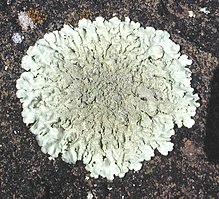Lichenometry

The lichenometry is a method of age determination , in the archeology , the paleontology , the glaciology , the Pedology , the geomorphology and the paleoseismology the growth of lichens to determine attracts around the age of exposed rock or a built-cut stone. It was introduced in 1957 by the Austrian scientist Roland Beschel .
The method is based on an assumed specific growth rate of the lichens, which for crustal lichens is around 0.5–2 mm per year. The age of the lichen can be calculated from the diameter of the examined lichen and the known growth rate, and thus the time that the rock has been exposed.
Lichen can live up to 4,500 years. This period also represents the maximum period of application and thus only includes the Holocene . Nevertheless, it is very accurate with an error limit of 10%, at least when it is applied to rocks that have been exposed for less than 1000 years. It is mainly used where other methods such as dendrochronology or the radiocarbon method cannot be used. Suitable lichens for lichenometry due to their long age include Aspicilia cinera , Aspicilia caesiocinera , Biatorella testudinea , Lecidea promiscens , Lecidea lapicida , Rhizocarpon geographicum and Rhizocarpon alpicola .
Lichenometry allows the determination of recurrence intervals (for earthquakes above a certain strength) and the detection of the spatial spread of earthquake damage (assuming that matching lichen diameters in an area are due to the same seismic event) on blocks of rock that were poured as a result of earthquake activity to let).
Problems with this method, which is not undisputed, result from the correct identification of the species, the period between the exposure of the rock and the colonization by lichens, different growth rates between individual regions and over time, the different climatic influences and the determination of the largest lichens.
literature
- Georg Masuch: biology of lichens. Source and Meyer Verlag, Wiesbaden 1993, ISBN 3-8252-1546-6 .
- Thomas Nash III: Lichen biology . 2nd Edition. Cambridge University Press, Cambridge 2008, ISBN 978-0-521-69216-8 .
Web links
- Lichenometry for dating moraines
- Lichenometry as a method for tectonic geomorphology , script tectonic geomorphology. of the TU Freiberg. SS 2010, page 7.
- Olga Solomina , Mikhail Ivanov, Tom Bradwell . Lichenometric studies on moraines in the Polar Urals .